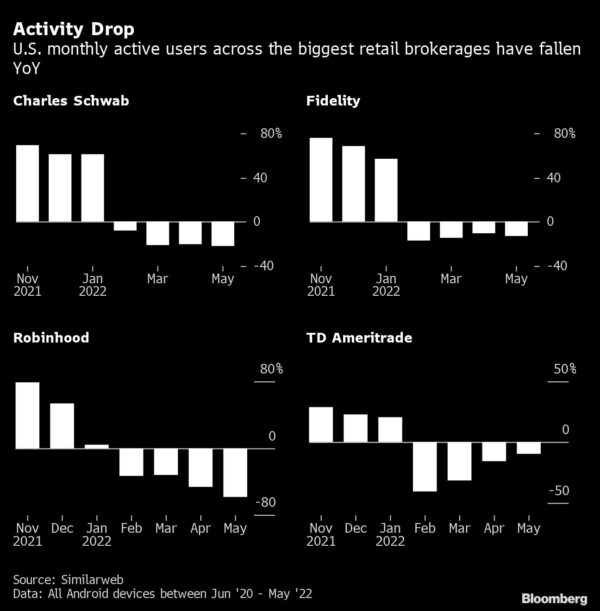By Charlie Wells, Misyrlena Egkolfopoulou and Claire Ballentine
The “fear of missing out” that characterized so much of the investing landscape over the past two years is disintegrating into another, much simpler emotion: fear itself.
For Nikole Vicente, that meant watching her crypto portfolio plunge about 50% since November, wiping away $30,000.

The 30-year-old Canadian had been investing in crypto on the side, but when the wellness company where she worked was sold in February she decided to take the opportunity to move exclusively into crypto. She moved to Mexico using her earnings, which came primarily from the DeFi space and alt coins.
Now, she’s pivoted to helping people market their crypto projects on Twitter, and is positioning her portfolio more toward stablecoins and “blue chip” cryptocurrencies like Bitcoin and Ethereum.
“With the recession looming and inflation, everyone has this fear and everyone in the crypto market also reacts to that fear,” she said. “That’s scary when holding on for dear life.”
When the vibes shifted, they shifted fast.
The astounding $60 billion wipeout of Terra’s stablecoin in May led already-jittery cryptocurrencies to plummet. And it’s gotten worse. Bitcoin has now slumped for 11 days straight, its longest streak of declines ever. Ethereum is down about 70% since the start of the year. Crypto exchange Coinbase Global Inc. said this week it will lay off 18% of its workforce. And crypto lenders Celsius Network and Babel Finance have halted withdrawals, accelerating the slump.
“There’s so much fear right now in everything,” said Oliver Jones, a 29-year-old software engineer from outside London who started consistently trading crypto in 2020. With everything falling for weeks and weeks, he says “it feels like throwing money into a fire.”
Not Fun
The downturn follows nearly two years of ebullience, which saw Bitcoin skyrocket from below $5,000 in March 2020 to nearly $70,000 in November 2021. That was accompanied by froth in many other risky asset classes as young people — stuck at home because of the pandemic, with money to burn from stimulus checks and spurred on by like-minded people on forums like Reddit’s WallStreetBets — picked up trading for the first time. Crypto was a retail-trader favorite, and new concepts like NFTs and DeFi provided eye-popping returns, at least temporarily.
The vibe shift hasn’t only been in the crypto space, of course. Inflation is the hottest it’s been in four decades, Wall Street is settling into a bear market, recession fears are growing, and the meme stocks that made up “retail mania” are sinking back into the doldrums they floated in for years before their rediscovery by bored day traders on Reddit.
It’s apparent when looking at monthly active users on Robinhood, the gateway investing platform for many new traders, which fell almost 60% in May compared to a year earlier, according to data by Similarweb, which tracks website activity on the Android operating system. The story is similar across most other online brokerages.
Julian Barrios, 26, went from making as much as $800 a week trading options to less than $100. Eventually, he stopped trading options altogether because of the wild swing in prices.
“It takes the fun out of it seeing all the volatility,” said the mechanic from Fort Lauderdale, Florida. “Right now, you’re definitely going to get frustrated or stressed out. The past two months were really tough for me.”
Frustration and Stress
Some are calling it the start of another “crypto winter.” The phrase is most often used to describe the period of stagnation from early 2018 to mid-2020, when prices languished and innovation withered, before retail mania sent everything surging again.
Coinbase Chief Executive Officer Brian Armstrong referenced the idea in the note he sent his employees the day of the layoffs, and later posted on the company’s blog.
“We appear to be entering a recession after a 10+ year economic boom,” he wrote. “A recession could lead to another crypto winter, and could last for an extended period.”
Gareth MacLeod was one of the people who got out of crypto during the last winter. The 35-year-old software engineer from the Toronto area cofounded a crypto market-making firm called Tinker in 2014 with the help of the Y Combinator startup accelerator in California. He rode the rise until prices started crashing, then he looked around and realized he just didn’t believe in the mission anymore.
It’s easy to silence any doubt when prices keep rising and investors are piling into your startup, MacLeod said.
“I was only able to reevaluate my relationship with crypto and with the industry because things had gone down,” he said. “I’m glad that happened to me.”
At this point, some investors say they’re taking a break from online trading, if not stepping away entirely. Mike Janavey, a 32-year-old from Westchester, New York, who was active in trading meme-stock favorites AMC Entertainment Holdings Inc. and GameStop Corp. last year, said he’s focusing more on real-world projects. These include a footwear and clothing design manufacturing business.

“I wanted to let it rest for a bit, take some gains and not let it take over my focus on my actual life,” he said.
Others are shifting to more traditional investing platforms. Andy Slye, a 32-year-old from Louisville, Kentucky, who works in IT and hosts a popular Tesla-oriented YouTube channel, transferred his portfolio to Fidelity from Robinhood, which has been criticized for using game-like features to keep users coming back. He first started using Robinhood after hearing about it on Reddit, but felt he needed something a bit more grown-up.
“Maybe this is sort of like getting older and not really needing that gamification for investing, knowing that it’s more serious than that,” he said.
More stories like this are available on bloomberg.com.




